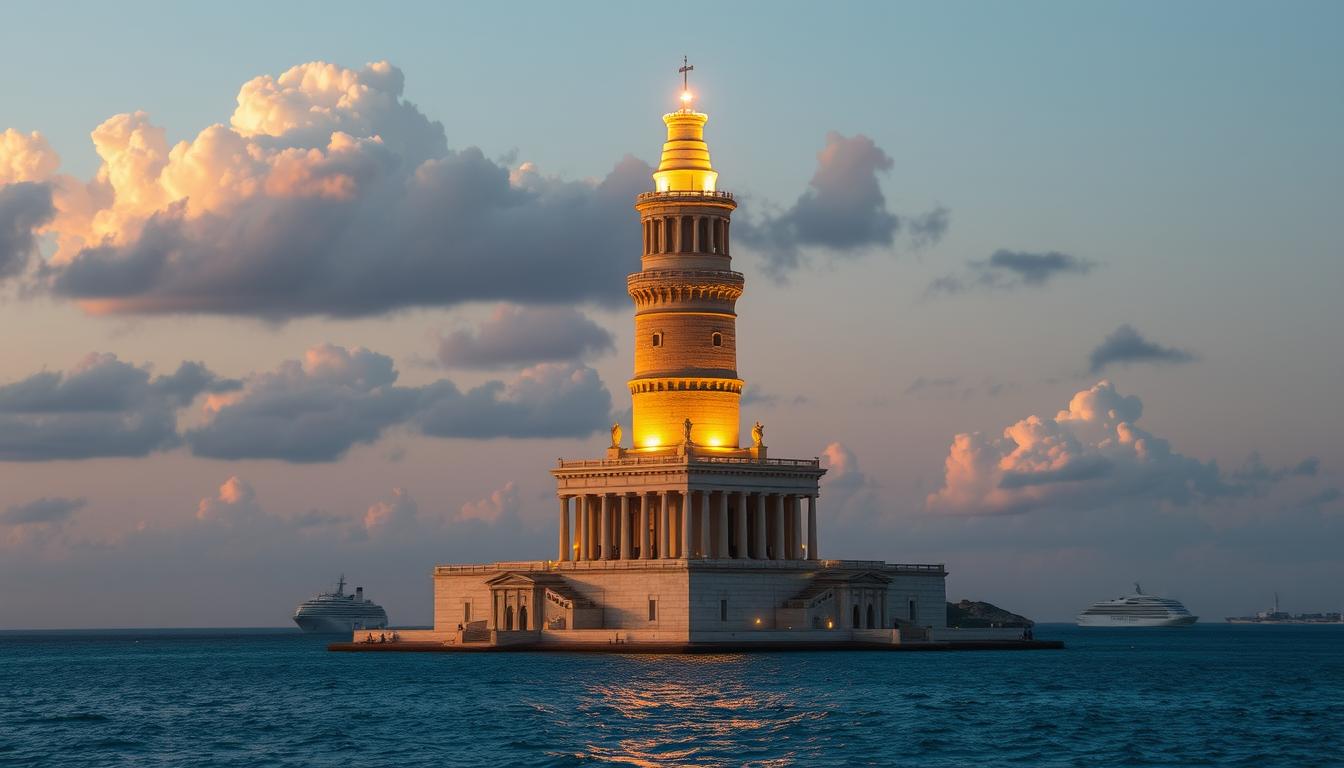The Pharos of Alexandria, standing tall on the Mediterranean’s shores, was a marvel of ancient architecture. It was one of the Seven Wonders of the Ancient World. This massive lighthouse not only guided ships but also highlighted the Ptolemaic dynasty’s engineering and cultural achievements.
Built in the 3rd century BCE, the Pharos showcased the ambition and ingenuity of its builders. It served as a beacon for sailors in the Mediterranean’s dangerous waters. This lighthouse also reflected the Ptolemaic kingdom’s power, making Alexandria a vibrant ancient wonder and architectural center.
Key Takeaways
- The Pharos of Alexandria was one of the Seven Wonders of the Ancient World, a colossal lighthouse that stood as a symbol of the Ptolemaic dynasty’s power and prosperity.
- The lighthouse played a crucial role in ancient Mediterranean trade, guiding ships through the treacherous waters and establishing Alexandria as a major maritime hub.
- The architectural and engineering marvels of the Pharos, including its three-tiered structure and innovative lighting system, have left a lasting legacy on lighthouse design and maritime safety.
- The Pharos has inspired countless myths, legends, and artistic representations, cementing its place as an enduring icon of the ancient world.
- Ongoing archaeological research and modern interpretations continue to shed light on the Pharos, its significance, and its enduring cultural impact.
Historical Significance of the Pharos of Alexandria
The Pharos of Alexandria, an iconic landmark of the ancient world, held immense historical significance. It was more than just a towering lighthouse. Constructed during the Ptolemaic dynasty, this remarkable structure played a pivotal part in facilitating ancient Mediterranean trade. It symbolized the power of the ruling Ptolemaic Dynasty.
Role in Ancient Mediterranean Trade
The Pharos of Alexandria served as a crucial maritime beacon. It guided ships through the treacherous waters of the Mediterranean Sea. Its strategic location at the entrance of the city’s harbor made it indispensable for the thriving maritime trade.
This trade connected Alexandria to the broader ancient world. The lighthouse’s illumination allowed for safer navigation. This enhanced the city’s status as a commercial hub and contributed to the region’s economic prosperity.
Symbol of Ptolemaic Power
The Pharos of Alexandria stood as a testament to the might and ambition of the Ptolemaic Dynasty. Commissioned by Ptolemy I Voter, the lighthouse was an engineering marvel. It was also a symbol of the dynasty’s desire to assert its dominance in the Mediterranean.
The structure’s grand scale and architectural brilliance reflected the Ptolemaic rulers’ commitment. They wanted to showcase Alexandria’s prominence as a center of power and culture.
Cultural Impact on the Ancient World
Beyond its practical applications, the Pharos of Alexandria left an indelible mark on the cultural landscape of the ancient world. The lighthouse’s iconic status inspired countless artistic representations, literary references, and legendary tales. These continue to captivate scholars and enthusiasts alike.
Its enduring legacy as one of the Seven Wonders of the Ancient World underscores its profound impact. The Pharos had a significant impact on the collective imagination and cultural heritage of the ancient Mediterranean civilizations.
“The Pharos of Alexandria stood as a testament to the might and ambition of the Ptolemaic Dynasty.”
Architectural Marvel: Construction and Design
The Pharos of Alexandria was a true marvel, showcasing the hellenistic engineering skills of its era. This colossal statue and beacon of navigation was crafted with precision, blending innovative techniques with stunning visuals.
The lighthouse’s base was a massive square, built with precision-cut stone blocks. This solid foundation supported the entire structure. Above, an octagonal middle section showcased the architects’ creativity and problem-solving skills.
The tower’s cylindrical shape, with its tapering silhouette, was a sight to behold from afar. Adorned with intricate carvings, it further solidified the Pharos’ status as a marvel of ancient engineering.
The construction was a remarkable achievement, requiring the collaboration of skilled stonemasons, architects, and laborers. Advanced techniques, like mortar use and stone placement, ensured the lighthouse’s durability against harsh coastal conditions.
The Pharos of Alexandria stood as a symbol of Hellenistic ingenuity and ambition. It set a new benchmark for lighthouse design and engineering, influencing maritime navigation and architecture for centuries.
“The Pharos of Alexandria was a true marvel of ancient architecture, a testament to the ingenuity and vision of its builders.”
The Three-Tiered Structure of Ancient Wonder
The Pharos of Alexandria, a legendary lighthouse, was one of the Seven Wonders of the Ancient World. It was celebrated for its three-tiered structure, a masterpiece of the Ptolemaic era. This pharos of alexandria combined beauty and utility, impressing all who saw it with its grandeur and innovative design.
Lower Level: Square Base Construction
The Pharos’s foundation was a massive, square base made of solid white marble. This base was not just a foundation but a showcase of ancient engineering skills. It measured about 60 feet on each side, providing a solid base for the lighthouse’s impressive design.
Middle Section: Octagonal Design
The middle section of the Pharos featured an octagonal design, a bold architectural choice. This design added visual appeal and enhanced the structure’s stability. The eight-sided section, crafted from limestone, tapered inward, showcasing the elegance of monumental architecture from that era.
Upper Level: Cylindrical Tower
The top level of the Pharos was a cylindrical tower, housing the powerful light that guided ships. The circular design, likely made of polished granite, maximized visibility, ensuring the lighthouse’s signals could be seen far out at sea.
The Pharos of Alexandria’s three-tiered structure was a marvel of ancient monumental architecture. It perfectly combined form and function, reflecting the Ptolemaic dynasty’s ingenuity and ambition. Each level played a vital role in the lighthouse’s design and purpose, cementing its status as a symbol of engineering excellence and cultural importance.
Engineering Brilliance Behind the Lighthouse
The Pharos of Alexandria, an iconic beacon of navigation in the ancient world, was not just an architectural wonder. It was also a symbol of the hellenistic engineering excellence of its creators. Its innovative lighting system and use of mirrors showcased the technological advancements of the Ptolemaic era.
The Pharos’s design centered around its advanced lighting mechanism. It used a central fire and reflective surfaces to project a powerful beam of light. This system, powered by wood and oil, could guide ships from miles away. It was a crucial aid for ancient sailors navigating the Mediterranean’s dangers.
| Feature | Description |
|---|---|
| Lighting System | Central fire and reflective surfaces to project a powerful beam of light |
| Fuel Source | Wood and oil |
| Visibility Range | Able to guide ships from miles away |
The Pharos also utilized advanced mirror technology to boost its signaling capabilities. Its upper platform featured a series of bronze mirrors. These were positioned to reflect sunlight during the day and the central fire’s glow at night. This system allowed the Pharos to function as a reliable beacon of navigation for both day and night.
The Pharos’s structural integrity was another testament to hellenistic engineering. Its three-tiered design, with a square base, octagonal middle, and cylindrical upper tower, was visually striking. It also ensured stability and resilience against the elements.
The engineering genius behind the Pharos of Alexandria highlights the technological progress of the Ptolemaic era. This iconic structure, a beacon of navigation for centuries, still fascinates scholars and enthusiasts. It offers a glimpse into the engineering wonders of the ancient world.
Pharos of Alexandria.light hose: Evolution Through Ages
The Pharos of Alexandria, a marvel from the Ptolemaic dynasty, has fascinated us for centuries. Its story of survival and change is a testament to history’s dynamic nature. It shows us the ancient world’s ever-changing landscape.
Original Construction Period
Ptolemy I Soter commissioned the Pharos in the 3rd century BC. It was a symbol of the Ptolemaic dynasty’s power and ambition. Designed by Sostratus of Cnidus, it combined practicality with grandeur.
Major Renovations and Changes
Through the ages, the Pharos underwent many changes. The Romans reinforced and expanded it, keeping it relevant as a navigation beacon. This ensured its continued importance in the ptolemaic dynasty.
Final Days of the Structure
The Pharos’s glory days ended in the 14th century. Earthquakes and disasters led to its collapse. The once-mighty ancient wonder was reduced to rubble, leaving a lasting void in the Mediterranean.
Though it fell, the Pharos of Alexandria’s legacy lives on. It inspires people worldwide with its tale of human ingenuity and the resilience of ancient wonders against time.
Ancient Navigation and Maritime Safety
The Pharos of Alexandria was a crucial landmark in ancient maritime history. It served as a beacon, improving navigation and safety for those sailing the Mediterranean. This towering lighthouse lit up the Alexandria harbor, guiding ships through dangerous waters. It ensured the safe passage of vessels involved in the region’s booming maritime trade.
The lighthouse’s strategic location and height made it invaluable for ancient sailors. Its bright flame could be seen from miles away, helping ships find the harbor entrance. This reduced the risk of shipwrecks and accidents. As a result, Alexandria, a key commercial center during the Ptolemaic era, flourished.
| Feature | Description |
|---|---|
| Height | Approximately 135 meters (443 feet), making it one of the tallest ancient structures |
| Visibility | The light could be seen from up to 35 miles (56 kilometers) away, guiding ships to the harbor |
| Significance | Played a crucial role in the maritime history of the Mediterranean, enhancing navigation and maritime safety |
The Pharos of Alexandria’s role as a beacon of navigation highlights its significant impact on maritime history. Its towering presence and light provided essential service to sailors. It greatly contributed to the safety and efficiency of ancient maritime trade and transportation.
Myths and Legends Surrounding the Pharos
The iconic landmark known as the Pharos of Alexandria has been shrouded in myths and legends for centuries. These tales range from ancient folklore to documented historical accounts. The ancient wonder has long fascinated people, capturing their imaginations.
Ancient Stories and Folklore
One famous legend tells of Sostratus of Cnidus, the architect of the Pharos. It’s said he inscribed his name on the lighthouse’s foundation, hidden beneath a layer with the Ptolemaic king’s name. This move was meant to ensure his name would be remembered forever.
Historical Accounts and Records
There are also historical records that shed light on the Pharos’s significance. Strabo, an ancient Greek historian, described it as a “very large and very high structure” visible from afar. Pliny the Elder, a Roman author, highlighted its impressive height and the complex engineering that went into its construction.
“The Pharos of Alexandria was a marvel to behold, a testament to the ingenuity and ambition of the ancient world.”
These historical accounts, along with the myths and legends, have cemented the Pharos’s status as a iconic landmark and ancient wonder of the ancient Mediterranean world.
Archaeological Discoveries and Research
The Pharos of Alexandria, a marvel among the Seven Wonders of the Ancient World, has long fascinated scholars. Through extensive archaeological digs and advanced research, we’ve gained profound insights into this legendary lighthouse. Its legacy continues to captivate us.
Underwater excavations in the ancient harbor of Alexandria have uncovered a wealth of artifacts. These finds include intricate stone carvings, wrought-iron fittings, and parts of the original lighting system. Such discoveries offer crucial clues about the Pharos’ engineering marvel.
Land-based digs have also revealed significant historical records. Inscriptions, coins, and other documents shed light on the Pharos’ cultural importance. They help us understand its role in ancient trade and commerce. These findings have allowed scholars to piece together the lighthouse’s history, from its construction to its decline.
| Key Archaeological Discoveries | Significance |
|---|---|
| Underwater excavation of submerged ruins | Recovered architectural fragments, lighting system remnants, and other artifacts that provide insights into the lighthouse’s design and construction |
| Land-based archaeological digs | Uncovered inscriptions, coins, and historical records that shed light on the Pharos’ cultural impact and its role in ancient trade |
| Ongoing research and analysis | Continuously expanding our knowledge of the Pharos, its evolution, and its lasting influence on maritime history and architecture |
The archaeological discoveries and ongoing research have been crucial in preserving the Pharos of Alexandria’s memory. As we continue to uncover new insights, this iconic landmark remains a testament to ancient ingenuity and ambition.
Modern Interpretations and Cultural References
The Pharos of Alexandria, a marvel of the ancient world, has deeply influenced modern culture. It has been celebrated in art and literature, captivating audiences worldwide. This iconic landmark continues to inspire and fascinate people globally.
Artistic Representations
Artists have long been captivated by the Pharos. Its architectural beauty and historical importance have made it a staple in various art forms. From paintings to sculptures, the Pharos has been reimagined countless times, each interpretation offering a fresh perspective on this iconic landmark.
Literary Mentions
The Pharos has also made its mark in literature. Authors have woven stories around this iconic landmark, capturing its majesty and symbolism. Its influence spans from ancient texts to contemporary novels, inspiring creative storytelling and engaging readers.
Modern Cultural Impact
The Pharos of Alexandria’s influence extends beyond art and literature. It has left a significant cultural impact on the modern world. Its legacy as a symbol of power, navigation, and innovation is reflected in various aspects of popular culture. The Pharos remains a source of fascination, reminding us of ancient civilizations’ ingenuity and ambition.
The Pharos of Alexandria is a testament to the lasting cultural impact of this iconic landmark. Its influence on art, literature, and society highlights the profound and lasting impression it has made on the world.
Impact on Modern Lighthouse Design
The Pharos of Alexandria, an ancient wonder, has profoundly shaped modern lighthouse design. As a beacon of navigation in the ancient Mediterranean, it inspired countless engineers and architects. They aimed to enhance maritime safety and innovation.
The Pharos’ design, with its square base, octagonal middle, and cylindrical top, has become a standard. This layout ensures stability and visual impact in lighthouses worldwide. It has been a cornerstone in the evolution of lighthouse architecture.
The Pharos also set a precedent in material and construction techniques. Its use of marble and advanced engineering principles has influenced modern lighthouse design. This legacy has cemented the iconic and durable nature of today’s lighthouses. They continue to serve as beacons of navigation for sailors globally.
The Pharos of Alexandria’s impact on lighthouse design is both timeless and significant. Its influence on maritime safety and exploration is undeniable. It stands as a symbol of architectural brilliance and engineering prowess, forever etched in history.
Conclusion
The Pharos of Alexandria, a marvel among the Seven Wonders of the Ancient World, showcases the ingenuity and ambition of the ancient Egyptians. This iconic structure, initially a lighthouse, has evolved into a symbol of the Ptolemaic dynasty’s might. It has also become a landmark that has fascinated people across history.
The ancient wonder of the Pharos of Alexandria was a testament to its designers’ engineering skills. Its design, featuring a square base, an octagonal middle, and a cylindrical top, highlighted ancient construction techniques. It also demonstrated the use of natural resources, like sunlight, to create a functional and impressive lighthouse.
The legacy of the Pharos of Alexandria goes beyond its physical form. It has inspired countless architects, artists, and writers, who have tried to capture its grandeur in their works. From literary references to contemporary interpretations, the Pharos of Alexandria continues to captivate. It reminds us of our ancestors’ ingenuity and ambition, and the lasting impact of ancient wonders on our understanding of history and our dreams for the future.
FAQ
What was the Pharos of Alexandria?
The Pharos of Alexandria was a monumental lighthouse among the Seven Wonders of the Ancient World. It stood on Pharos Island, off Alexandria’s coast in Egypt. This architectural marvel served as a beacon for ancient maritime trade in the Mediterranean.
What was the purpose of the Pharos lighthouse?
The Pharos lighthouse was a beacon for ships entering Alexandria’s harbor. Its light was visible from miles away, guiding sailors and boosting ancient Mediterranean trade.
When was the Pharos of Alexandria built?
Ptolemy I Soter, a general of Alexander the Great, commissioned the Pharos in the 3rd century BCE. It took over 20 years to complete this massive structure.
What were the architectural features of the Pharos?
The Pharos featured a unique design with a square base, an octagonal middle, and a cylindrical top. These elements showcased advanced Hellenistic engineering, creating a towering lighthouse.
How tall was the Pharos of Alexandria?
The Pharos was estimated to be around 400 feet tall. Its size and grandeur made it a landmark and one of the Seven Wonders of the Ancient World.
What happened to the Pharos of Alexandria?
The Pharos stood for over 1,600 years until damaged by earthquakes and natural disasters. By the 14th century, it was in ruins, with only a small part remaining.
How did the Pharos influence lighthouse design and maritime history?
The Pharos’s design and engineering innovations influenced lighthouse construction worldwide. Its three-tiered structure and lighting system set a precedent, marking its legacy in ancient engineering.
What were some of the myths and legends surrounding the Pharos?
The Pharos was surrounded by myths and legends. Stories included a giant Poseidon statue at its top and the use of mirrors to magnify light, aiming to burn ships.
How have modern researchers studied the Pharos?
Modern research has shed light on the Pharos. Underwater excavations, architectural analysis, and ancient texts have deepened our understanding of this ancient wonder.



